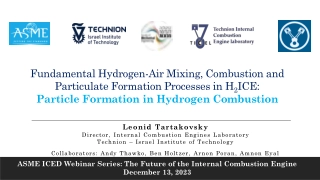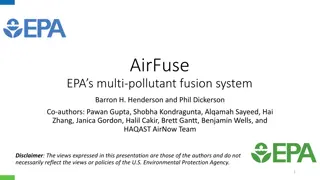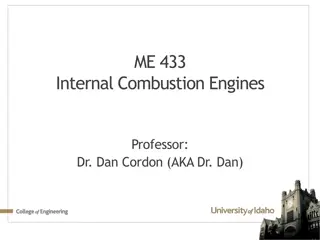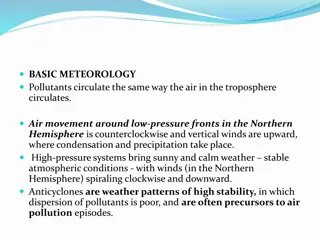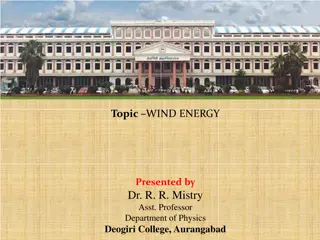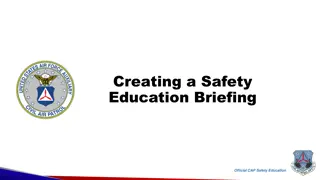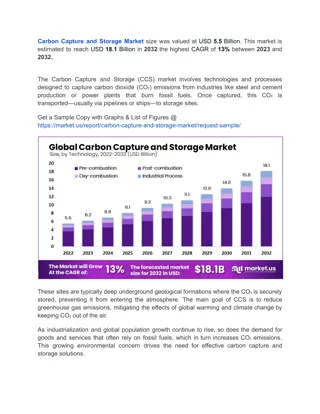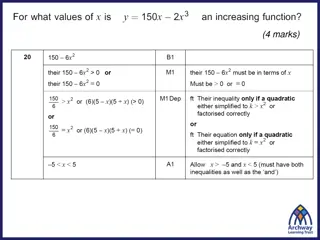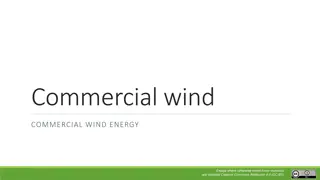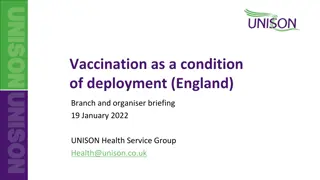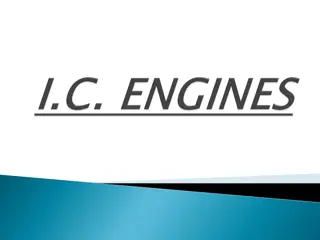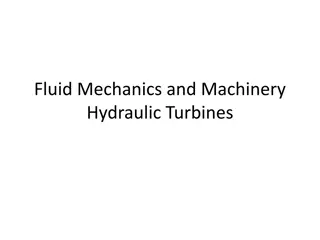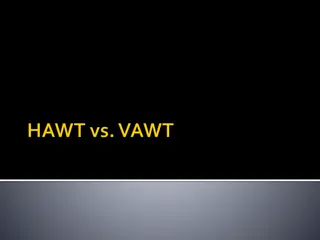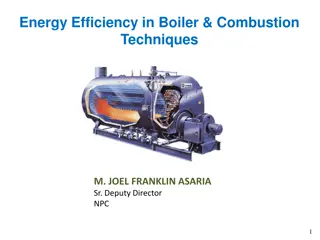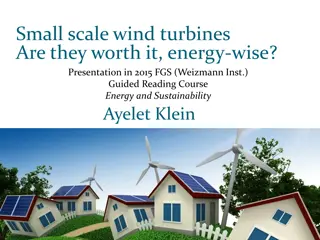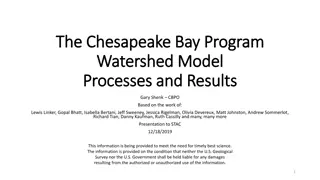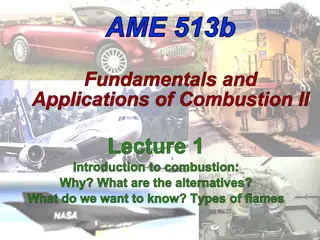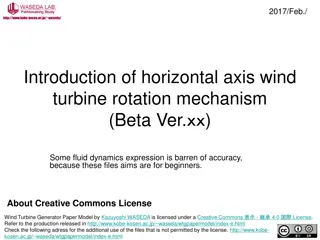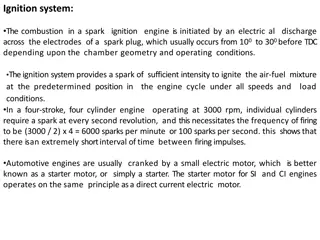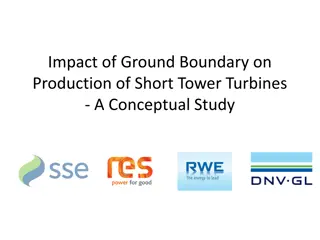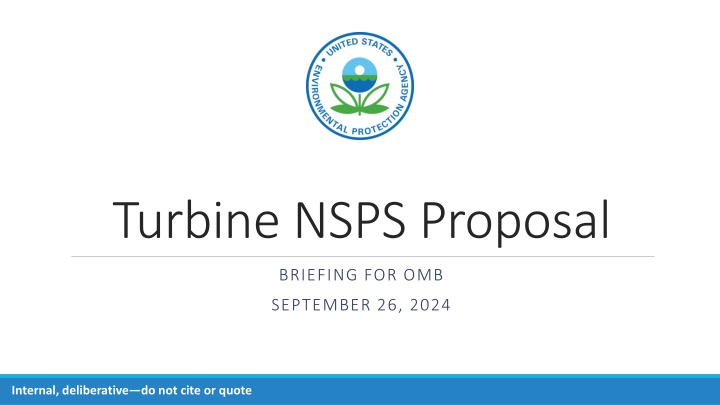
Stationary Combustion Turbines Criteria Pollutant NSPS Proposal Briefing
The proposal addresses NOX and SO2 emissions standards for new combustion turbines, outlines stringent NOX limits, and seeks feedback on control technologies and costs. It also maintains current SO2 standards and considers direct PM standards. The document discusses proposed subcategories and NOX standards aligned with Carbon Pollution Standards Size Utilization Subcategory. It introduces changes in subcategories, standards based on different load percentages, and identifies SCR as a new BSER for certain turbines.
Download Presentation

Please find below an Image/Link to download the presentation.
The content on the website is provided AS IS for your information and personal use only. It may not be sold, licensed, or shared on other websites without obtaining consent from the author. If you encounter any issues during the download, it is possible that the publisher has removed the file from their server.
You are allowed to download the files provided on this website for personal or commercial use, subject to the condition that they are used lawfully. All files are the property of their respective owners.
The content on the website is provided AS IS for your information and personal use only. It may not be sold, licensed, or shared on other websites without obtaining consent from the author.
E N D
Presentation Transcript
Turbine NSPS Proposal BRIEFING FOR OMB SEPTEMBER 26, 2024 Internal, deliberative do not cite or quote
Background The criteria pollutant standards for new, modified, and reconstructed combustion turbines were last amended in 2006 under 40 CFR part 60, subpart KKKK includes standards for NOX and SO2. Original consent decree deadline for signature of this proposal was November 7, 2024 Plaintiffs (EDF and Sierra Club) have agreed in principle to an extension to November 22, 2024 Will impact new stationary combustion turbine engines with a base load rated heat input of 10 MMBtu/h or greater (~ 1 MW electric output) Broad sector that affects utility turbines as well as industrial turbines First of three actions in the comprehensive combustion turbine initiative Internal, deliberative do not cite or quote 2
Stationary Combustion Turbines Criteria Pollutant NSPS Proposal Key aspects of the proposal: Assures every new stationary combustion turbine in both the utility and industrial sectors is well- controlled for NOX and SO2 emissions Sets more stringent NOX emission standards for most subcategories of stationary combustion turbines Determines the BSER is combustion controls with the addition of selective catalytic reduction (SCR) for frequently used turbines in all subcategories Establishes NOX limits that specifically address the impacts of firing or co-firing hydrogen Solicits comment on control technologies, costs, and potential NOX standards for certain subcategories and identifies certain areas where commenter-supplied data would be helpful Proposes to maintain the current standards for SO2 emissions, because we concluded that no change is warranted as the standards are already based on the use of low-sulfur fuels (e.g., natural gas or distillate fuels) Requests comment on standards for direct PM (while we will have standards in the new NESHAP rules, we have not identified a BSER technology for the NSPS) Internal, deliberative do not cite or quote 3
Proposed Subcategories and NOx Standards Aligns with subcategorization approach in Carbon Pollution Standards Size Utilization Subcategory Subpart KKKKa BSER* Subpart KKKKa NOX Standard* Subpart KKKK NOX Standard* Changes from KKKK subcategory (MMBtu/h) Low and Combustion controls 25 ppm 25-150 ppm Intermediate load ( 40% CF) 250 Eliminate 50 MMBtu/h subcategory; SCR-based standard for base load turbines Base load (> 40% CF) Low load ( 20% CF) Intermediate and Base load (> 20% CF) Low load ( 20% CF) Combustion controls + SCR Combustion controls 3 ppm 25-150 ppm 25 ppm 25-42 ppm Based on DLN for high efficiency turbines > 250 and 850 Combustion controls + SCR SCR is new BSER for intermediate and base load turbines 3 ppm 25-42 ppm Combustion controls 15 ppm 15 ppm No change > 850 Intermediate and base load (> 20% CF) Combustion controls + SCR SCR is new BSER for intermediate and base load turbines 3 ppm 15 ppm *The NOX standards and BSER reflect subcategories of combustion turbines firing natural gas only, and for new and reconstructed units only Internal, deliberative do not cite or quote 4
Considerations For Hydrogen Firing Under current subpart KKKK, combustion turbines firing < ~ 20 % hydrogen (by volume) are subcategorized as natural gas-fired combustion turbines (i.e., lower NOX limit) Under proposed KKKKa, this threshold would increase to 30 % (by volume) hydrogen Units co-firing < 30 % hydrogen would have same NOX controls and limits as natural gas-fired units Units co-firing > 30 % hydrogen would be subcategorized as non-natural gas-fired units Example: A turbine co-firing 25% hydrogen would be subject to a more stringent NOX standard under subpart KKKKa than KKKK Challenging to build a technical record that combustion turbines co-firing > 30 % hydrogen could achieve the same emission rates as natural gas-fired combustion turbines but we are soliciting comment and requesting information on a threshold higher than 30 % (by volume) We expect very few (if any) units to be firing substantially more than 30 % hydrogen until the 2030s (and would likely be covered under the next 8-year review of the NSPS) Sends an important signal to owners/operators of new sources with plans to combust hydrogen that they will be required to comply with stringent NOX standards like sources firing natural gas or distillate fuels Internal, deliberative do not cite or quote 5
Other Issues SCR effectively controls NOX but may result in increased emissions of ammonia and CO2 Not proposing to revise current SO2 standards Low-sulfur fuels continue to be industry standard Soliciting comment on use of ultra-low sulfur diesel in continental areas and availability of ultra- low sulfur diesel in noncontinental areas Proposal includes discussion of PM emissions being evaluated as part of upcoming NESHAP Broadly soliciting comment on combustion turbines with collocated battery storage Additional information would be helpful regarding specific facilities, their operations, battery storage systems, and how these are integrated into turbine operation and potential impacts on NOX emissions Internal, deliberative do not cite or quote 6
Outreach EPA continues to engage with EJ organizations and representatives of communities that are affected by fossil fuel-fired stationary combustion turbines EJ concerns include NOX emissions, especially from small-sized units that operate frequently Opened a non-regulatory docket with framing questions about ways the Agency could design a broad approach to the regulation of air pollutants from stationary combustion turbines Held a public policy forum at DC headquarters to facilitate an exchange of views and ideas concerning upcoming proposed regulations, including the NSPS for stationary combustion turbines Key groups represented included state and local air agencies, Tribal Nations, affected companies, representatives of the EJ community, technology vendors, environmental NGOs, and electric reliability organizations and trade groups Held a Federalism consultation with representatives of state and local governments Engaged with major combustion turbine manufacturers, including General Electric, Siemens, Mitsubishi, and Solar Turbines as well as the Gas Turbine Association Internal, deliberative do not cite or quote 7
Estimated New Units, Costs, and Emissions Changes Estimated New Units per Year Subcategory New Units per Year 250 MMBtu/h 44 > 250 MMBtu/h and 850 MMBtu/h 11 > 850 MMBtu/h 13 Total 68 Estimated Costs and Emissions Changes Cumulative Units with Increased Operating Costs Relative to Baseline 0 Annual NOX Emission Reductions Relative to Baseline (tons) Annual NH3 Emission Increases Relative to Baseline (tons) Annual CO2 Emission Increases Relative to Baseline (tons) Cumulative New Units Subject to NSPS Year Total Cost (2023$) 2025 0 $0 0 0 0 2026 0 0 $0 0 0 0 2027 0 0 $0 0 0 0 2028 68 13 $482,000 190 19 1,429 2029 136 26 $963,000 381 38 2,857 2030 204 39 $1,445,000 571 57 4,286 2031 272 52 $1,926,000 762 76 5,715 2032 340 65 $1,741,000 689 69 5,166 Internal, deliberative do not cite or quote 8
Net Benefits of Proposed Rule 2% Discount Rate Present Value Equivalent Annualized Value Monetized Benefits Total Annual Costs Monetized Disbenefits $7.58 and $24.7 $0.79 $4.0 and $7.7 $55.5 and $181 $5.76 $29.6 and $56.4 Any other climate, health, and environmental impacts or costs associated with increased use of existing emissions controls $20.2 and $119 Non-Monetized Impacts Net Benefits $2.8 and $16.2 Values in millions, $2023 The two benefits estimates are separated by the word and to signify that they are two separate estimates using different approaches and do not represent lower- and upper-bound estimates. Internal, deliberative do not cite or quote 9

